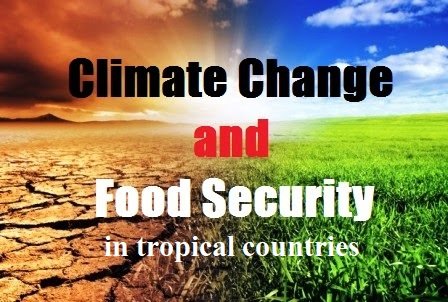Climate change has significant consequences for food security in tropical countries, affecting availability, accessibility, utilization, and stability of food. Here are the key impacts:
1. Impact on Food Availability:
Reduced Crop Yields:
- Temperature Rise: Higher temperatures can stress crops, reducing yields. Many staple crops, such as rice, maize, and wheat, have optimal temperature ranges for growth, and deviations can lead to lower productivity.
- Altered Rainfall Patterns: Changes in precipitation can lead to droughts or floods, both of which negatively impact crop yields. Droughts can cause water shortages, while floods can destroy crops and soil infrastructure.
Pests and Diseases:
- Increased Incidence: Warmer temperatures and changing precipitation patterns can create favorable conditions for pests and diseases, which can further reduce crop yields and increase the need for pesticides, potentially harming the environment and human health.
Soil Degradation:
- Erosion and Nutrient Loss: Extreme weather events, such as heavy rains, can lead to soil erosion and loss of soil fertility. This degrades the quality of agricultural land and reduces long-term productivity.
2. Impact on Food Accessibility:
Economic Challenges:
- Rising Food Prices: Reduced agricultural productivity can lead to higher food prices, making food less affordable for many people. This is particularly challenging in tropical countries where a large portion of the population may already be living in poverty.
- Income Losses: Climate change can affect the livelihoods of farmers and others dependent on agriculture, leading to reduced incomes and purchasing power. This can limit their ability to buy sufficient and nutritious food.
3. Impact on Food Utilization:
Nutritional Quality:
- Nutrient Loss: Higher CO2 levels can reduce the nutritional quality of some staple crops by lowering concentrations of essential nutrients like protein, zinc, and iron. This can exacerbate malnutrition, particularly in regions where diets are already limited in diversity.
- Dietary Changes: Reduced availability and higher prices of staple foods may force people to shift to less nutritious alternatives, impacting overall diet quality and health.
4. Impact on Food Stability:
Extreme Weather Events:
- Crop Failure and Supply Disruptions: Increased frequency and intensity of extreme weather events, such as hurricanes, cyclones, and heatwaves, can cause sudden and severe disruptions in food production and distribution systems, leading to periodic food shortages.
- Reliance on Imports: Some tropical countries may become more reliant on food imports due to decreased domestic production. This dependency makes them vulnerable to global market fluctuations and trade restrictions.
5. Socio-Economic and Political Consequences:
Migration and Displacement:
- Climate Refugees: Adverse climatic conditions can lead to internal and cross-border migration as people move in search of better living conditions and food security. This can create additional strain on urban areas and receiving regions.
- Conflict and Instability: Competition over dwindling resources, such as water and arable land, can lead to conflicts and exacerbate social and political instability. Food insecurity can be both a cause and a consequence of such conflicts.
6. Impact on Fisheries and Livestock:
Marine and Inland Fisheries:
- Temperature and Acidification: Warming ocean temperatures and acidification can affect fish stocks, reducing catches and impacting food security for communities dependent on fishing. Coral bleaching and the loss of marine biodiversity also threaten fish habitats.
- Freshwater Systems: Altered rainfall patterns and increased temperatures can affect freshwater fisheries, impacting local food supplies and livelihoods.
Livestock:
- Heat Stress: Higher temperatures can affect livestock health and productivity, reducing meat, milk, and egg yields. Heat stress can also impact reproduction rates and increase susceptibility to diseases.
- Feed and Water Scarcity: Climate change can reduce the availability of feed and water for livestock, further stressing these systems and affecting overall food production.
Adaptation and Mitigation Strategies:
Agricultural Practices:
- Climate-Resilient Crops: Developing and promoting the use of drought-resistant and heat-tolerant crop varieties can help maintain yields under changing climatic conditions.
- Sustainable Practices: Implementing sustainable agricultural practices, such as agroforestry, conservation agriculture, and integrated pest management, can enhance resilience to climate change.
Infrastructure and Technology:
- Irrigation Systems: Investing in efficient irrigation systems can help mitigate the impact of variable rainfall patterns and improve water use efficiency.
- Early Warning Systems: Developing early warning systems for extreme weather events can help farmers and communities prepare and respond more effectively.
Policy and Governance:
- Food Security Programs: Strengthening social safety nets and food security programs can help vulnerable populations cope with the impacts of climate change.
- International Cooperation: Collaborative efforts at regional and global levels are essential to address the transboundary nature of climate change impacts and to share resources, knowledge, and technologies.
Conclusion:
Climate change poses significant challenges to food security in tropical countries, affecting every aspect from production to consumption. Addressing these challenges requires a multi-faceted approach, including technological innovation, sustainable practices, and strong policy frameworks to build resilience and ensure food security for vulnerable populations.


